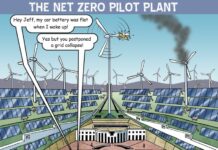Wind and solar energy have a fatal flaw – intermittency.
Solar generators won’t run on moon-beams – they stop as the sun goes down and every time that clouds block the sun. This happens at least once every day.
Our green energy bureaucrats have the solution – “Big Batteries”.
But big batteries bring new problems – they have to be re-charged by the same intermittent green generators needed to keep the lights on, the trains running, the electric cars, trucks and dozers charged, and to power the green hydrogen generators. So we need more generators and more batteries to keep the system powered – and so on.
Collecting dilute intermittent energy from all over a big continent like Australia and moving it to the big coastal cities and factories brings another green nightmare – an expensive and intrusive spider-web of power-lines that annoy landowners, degrade the environment, cause bushfires and are susceptible to damage from lightning, cyclones and sabotage. They call them solar “farms” and wind “parks” – they are neither farms nor parks – they are monstrous messy wind and solar power plants. And these very expensive “green” assets are idle, transmitting nothing, for most of most days.
Big batteries sitting in cities have proved a big fire risk and no one wants them next door. So our green “engineers” have another solution to these problems caused by their earlier “solutions” – “Mobile Batteries” (no one knows where they are).
Train entrepreneurs want to build “batteries on tracks” – a train loaded with batteries, which parks beside a wind/solar energy factory until the batteries are full. Then the battery train trundles off to the nearest city to unload its electricity, preferably at a profit. They can also play the arbitrage market – buy top-up power around midday and sell into peak prices at breakfast and dinner times when the green energy twins often produce nothing useful. This will have the added advantage of sending coal and gas generators broke sooner. Then battery trains can make a real killing.
This should be the perfect answer to supplying those energy-hungry AI data centres. Let’s start a pilot project and park a battery train beside the National AI Centre near CSIRO in Canberra.
A more ambitious plan is the B&B method – boats and batteries.
It would work like this:
The Australian government places an order with China to build a fleet of sail-assisted electric boats that are filled with batteries (and fire extinguishers). The batteries are charged with cheap coal-fired electricity at ports in China. They then sail to ports in Australia where the electricity can be un-loaded into the grid at appropriate times.
Australian mines can profit from the iron ore used to make the boats, the rare minerals used to build the batteries and the coal used by Chinese power plants to charge the batteries.
This solution allows Australian politicians to go to world conferences boasting that Australia’s electricity is Net Zero, and more tourists can be enticed to visit our endangered relics – coal mine and steam generator museums.
Of course there is another danger of the B&B solution – some entrepreneurs may load their boats with nuclear generators plus enough fuel on board for several decades of operation. Or they may even site a small nuclear reactor beside a closed coal power station and make use of all the ready-to-go power lines already in place.
This sort of dangerous thinking could well demolish another Queensland green dream – “CopperString” – a $5 billion speculation to build 840 km of new transmission line from Townsville to Mt Isa – they probably will not get there before the great copper mine and smelter at Mt Isa closes.
And why not just send a small nuke-on-a-train to Mt Isa?
What would a big hailstorm do to Sydney power supply:
Originally published at Richardson Post.










